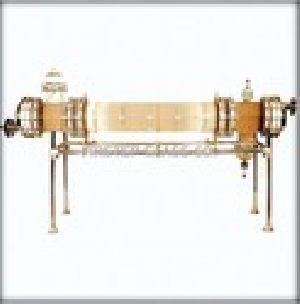
Glass Tube Heat Exchanger
50,000 - 150,000 Per Piece
1 Piece(s) (MOQ)
The shell & tube heat exchanger is a type of heat exchanger. It is the most common type of heat exchanger used in variuos chemical and pharmaceutical companies. It is suited for higher-pressure applications. This type of heat exchanger consists of a glass or metal shell (a large pressure vessel) with a bundle of tubes inside it. One fluid is passed through the tubes, and another fluid passes over the tubes (through the shell) to transfer heat between the two fluids. The set of tubes is called as tube bundle, and may be composed of several types of tubes.

Heatsink
Get Price Quote
In electronic systems, a heat sink is a passive heat exchanger component that cools a device by dissipating heat into the surrounding air.
Best Deals from Heat Exchangers

Glass Shell and Tube Heat Exchanger
Get Price Quote
Shell and Tube Heat Exchangers are one of the most common and versatile types of exchangers used in heat transfer applications. They allow transfer of large amounts of heat in a more compact construction than is possible with conventional coil type heat exchangers. Shell and Tube type Heat Exchangers find application as heaters, coolers, condensers, vaporizers, reboilers, etc. Pertinent Features of Shell Tube Heat Exchanger They have colossal Heat Transfer Surfaces. They have high Heat Transfer Coefficients. The sides of Shell, as well as Tubes, can be made diffusion and corrosion-resistant. Their Modular Design helps make the maintenance simple and also makes the reserves part stocking work efficiently. They can handle pressure up to +6 bar G. They are perfectly suitable for Pharmaceutical GMP applications that manufacture ultra-pure products. They are available with a different working capacity of heat transfer areas ranging from 0.3m2 to 50m2. They are highly resistant to corrosion, erosion, and oxidation across the full range of operating temperatures. Variants Translucent reinforced protective coating to prevent from accidents from breakage of glass Multi-Pass headers in Metal for more efficient heat transfer Vertical installation possible with minor modifications GMP, cleanroom models available in all types Tubes of exotic materials such as Hastelloy etc. available on request in the same design Other process connection sizes can be modified as per application and user requirement Tubes of SiC and graphite also available, offering higher thermal conductivity. Types of Shell And Heat Tube Exchangers TYPE-I: Both Sides Corrosion Resistant This is the universal and most common design of shell and tube heat exchanger, where both shell side and tube side are resistant to corrosion. It finds usage in applications such as condensation in the shell side, heat recovery, and cooling in a shell or tubes. With minor modifications, it can also be used as a falling film absorber and falling film evaporator. TYPE-II: Shell Side Corrosion Resistant Type-II Heat exchangers are very similar to TypesI but have Metal (Mild steel or Stainless Steel) Headers instead of glass headers. These are used in applications where there is no risk of corrosion at the service/utility side. The process side comes in contact only with the glass shell or PTFE components, and hence can be corrosive. Thus, this design 1’5 generally used for condensation and tempering of corrosive liquids. TYPE-III: Tube Side Corrosion Resistant Type-II Heat exchangers are very similar to Type-I but have Metal (Mild steel or Stainless Steel) Headers instead of glass headers. These are used in applications where there is no risk of corrosion at the service/utility side. The process side comes in contact only with the glass shell or PTFE components! And hence can be corrosive. Thus, this design is generally used For condensation and tempering 0f corrosive liquids. TYPE-IV: Shell Side Corrosion Resistant, High Tube Side Pressure! A key factor due to which maximum permissible pressure is limited in Shell & Tube Heat Exchangers is the Tube sheet, which cannot withstand a high pressure since it is made of pure PTFE. In applications where corrosion is not an issue at the utility side, a reinforcing plate can be installed at the header side of the PTFE Tube Sheet. This increases the maximum pressure limit up to 6 Bar. TYPE-V: Tube Side Corrosion Resistant; High Shell Side Pressure! This design of the Shell and Tube Heat exchanger again uses the reinforcing metal plate to increase maximum permissible operating pressure. However, in this type, the pressure is raised on the shell side since the plate is installed on the shell side of the Tube Sheet and not the header side.

Glass Heat Exchanger
Get Price Quote
Shell & tube heat exchangers offer large surface area in combination with efficient heat transfer and compactness. These are widely used in industries for various duties like cooling, heating, condensation, evaporation etc. GOEL are the pioneers in the field of glass shell and tube heat exchangers in India and their product has a wide market acceptability. Salient Features of Shell and Tube Heat Exchanger : 1.Universal corrosion resistance an excellent alternative to expensive MOCs like graphite, hastelloy, copper titanium, tantalum and other exotic metals. 2. Excellent heat transfer as fouling does not occur on smooth glass surfaces. 3. Flexibility of installation verticalhorizontal. 4. Easy replacement of tubes for repair and cleaning. 5. Available in wide range of HTAs. 6. Ease of installation due to light weight. 7. Economical. 8. Suitable for applications where large HTAs are required in limited space. Advantages of Shell and Tube Heat Exchanger Over Conventional Coil Type Heat Exchangers : 1. The overall heat transfer coefficient in shell and tube heat exchanger is about 3 times higher than in coil type heat exchanger. 2. The pressure drop in shell and tube heat exchanger is minimal compared to 2-3 kgcm2 in coil side of coil type heat exchanger. 3. For requirement of higher heat transfer areas shell and tube heat exchanger is the only alternative.

Coil Type Heat Exchanger
Get Price Quote
25 Piece(s) (MOQ)
We are offering coil type heat exchanger. coil type heat exchanger is mainly used as condenser or cooler. It can, however, be used for heat transfer between liquids & gases in general. It has the coil battery welded to the jacket making a one piece unit. The maximum allowable pressure in the coils is 2.7 bar gauge.

Heat Exchanger
Get Price Quote
Thermal and mechanical design of heat exchangers. Shell and tube type, Finned tube type heat exchangers. Waste Heat recovery units

Heat Exchanger
50,000 - 100,000 Per Rs
1 Nos (MOQ)
We are a leading manufacturer and supplier of Shell And Tube Heat Exchanger. Shell & tube type condenser is widely utilized to condense the processing vapors emitted from cooker and driers to suit a wide range of capacity requirements. The process vapors flow through the technologically advanced tubes while cooling water passes over the external surface in a counter flow arrangement.

Shell and Tube Heat Exchanger
Get Price Quote

Cooling Towers
Get Price Quote
Light Weight, High strength Excellent weatherability, Minimal maintenance and easy to manufacture integrated one-piece structure.

Glass Heat Exchanger
Get Price Quote
We are instruments in offering a proven range of glass heat exchanger, which is manufactured with precision using advanced machines. The glass heat exchanger offered by us, is known for its high performance and longer working life. Further, glass heat exchanger is available in two types i.e. Coil type and shell and tube type heat exchangers. Range coil type heat exchangers immersion heat exchanger sproduct coolers shell and tube heat exchangers

Heat Exchangers
Get Price Quote
Coil Type Glass Heat Exchanger Glass Boiler Glass Immersion Heat Exchanger Product Cooler Hose Connector Shell And Tube Type Glass Heat Exchanger There are two types of glass heat exchangers, coil type and shell and tube type. The overall heat transfer co-efficient of borosilicate glass equipment compare favourably with many alternative process plant construction materials. This is because the smooth surfaces of the glass improve the film coefficient and reduce the tendency for fouling.Two basic types of glass heat exchanger are described in this chapter, Coil type and Shell and Tube type. Shell and tube type heat exchangers are available with glass or Mild Steel (MS) Shells in combination with glass tube as standard. The shell, end bonnets can be supplied in other material of construction eg, CS, SS, PTFE lined, FRP, glass lined etc, depending on the process condition. The tube can also be supplied in Silicon Carbide. Shell & Tube Heat Exchanger consists of a cylindrical shell which uses a glass tube bundle. Tubes are fixed in the tube sheet. Each tube is individually sealed by PTFE 'O' ring in the tube sheet at both ends. Following are the advantage of using Shell & Tube heat exchangers : • Larger Heat Transfer Area in single unit• Low pressure drop• Easy Tube Replacement.• Tube can be Plugged in case of Breakage.Glass coil type heat exchangers are available as condensers, boilers or immersion type units with heat transfer areas up to 8m2. There are no internal sealing problems as the coil is welded to the shell making a one piece unit.

heat recovery wheel
Get Price Quote
We are engaged in manufacturing and supplying of premium quality heat recovery wheels. Our range of heat recovery wheel is manufactured using high quality basic materials and is effectively used in various industries. We also offer customization to our valuable clients in order to meet their increasing demands.

Heat Exchanger
Get Price Quote
A heat exchanger is a device used to transfer heat between two or more fluids. The fluids may be separated by a glass wall to prevent mixing. They are widely used in chemical plants, petrochemical plants, petroleum refineries & natural-gas processing.

Glass Heat Exchanger
5,000 Per Number
1 Number (MOQ)

Glass Heat Exchanger
Get Price Quote
Glass heat exchanger offer large surface area in combination with efficient heat transfer and compactness. These are widely used in industries for various duties like cooling, heating, condensation, evaporation etc. GOEL are the pioneers in the field of glass shell and tube heat exchangers in India and their product has a wide market acceptability.

Tube Heat Exchanger
Get Price Quote
We are a prominent organization, which is engaged in manufacturing, supplying and trading a wide array of Tube Heat Exchanger. The offered range of glass shells is manufactured by our experts in accordance with the industry laid standards. We are offering these glass shell heat exchangers in various specifications to meet the exact requirements of the customers. Further, clients can also avail customization solutions from us for these glass shell heat exchangers. It is also known as Glass Shell Heat Exchanger. Remarkable features of these glass shell heat exchangers are mentioned below: High performance Reliable operation Easy installation No maintenance

Heat Exchanger Tube
Get Price Quote
Heat Exchanger Tube, Steel Sheet, TMT Bar, Steel Rods, Fabrication Service

Heat Exchanger
Get Price Quote
Get in touch with us for acquiring premium Heat Exchanger at the most affordable prices in the market. Our Exchanger is known for its excellent quality and durability. Low pressure drop and easy tube replacement are some of the main attributes of our Exchanger. We can provide Heat Exchanger in small as well as bulk quantities to meet the diverse demands of buyers. Description : The overall heat transfer co-efficient of borosilicate glass equipment compare favourably with many alternative process plant construction materials. This is because the smooth surfaces of the glass improve the film coefficient and reduce the tendency for fouling. Two basic types of glass heat exchanger are described in this chapter, Coil type and Shell and Tube type. Shell and tube type heat exchangers are available with glass or Mild Steel (MS) Shells in combination with glass tube as standard. The shell, end bonnets can be supplied in other material of construction eg, CS, SS, PTFE lined, FRP, glass lined etc, depending on the process condition. The tube can also be supplied in Silicon Carbide. Shell & Tube Heat Exchanger consists of a cylindrical shell which uses a glass tube bundle. Tubes are fixed in the tube sheet. Each tube is individually sealed by PTFE 'O' ring in the tube sheet at both ends. Following are the advantage of using Shell & Tube heat exchangers : Larger Heat Transfer Area in single unit Low pressure drop Easy Tube Replacement. Tube can be Plugged in case of Breakage. Glass coil type heat exchangers are available as condensers, boilers or immersion type units with heat transfer areas up to 8m2. There are no internal sealing problems as the coil is welded to the shell making a one piece unit. Both types of heat exchangers are available in a wide range of nominal bores and are totally compatible with the other glass process plant and pipeline components described in the other chapters of this catalogue. Glass heat exchangers have standard flat buttress end connection (with the exception of service connections on some smaller units). Further details of these are provided in chapter 1 - Technical Information. DN refers to the nominal bore. Unless otherwise stated, all dimensions are given in mm. In Shell & Tube Heat Exchanger Multi-pass (up to 4 pass-tube side) can be supplied request.

Heat Exchanger Tube
Get Price Quote
We are offering heat exchanger tube.